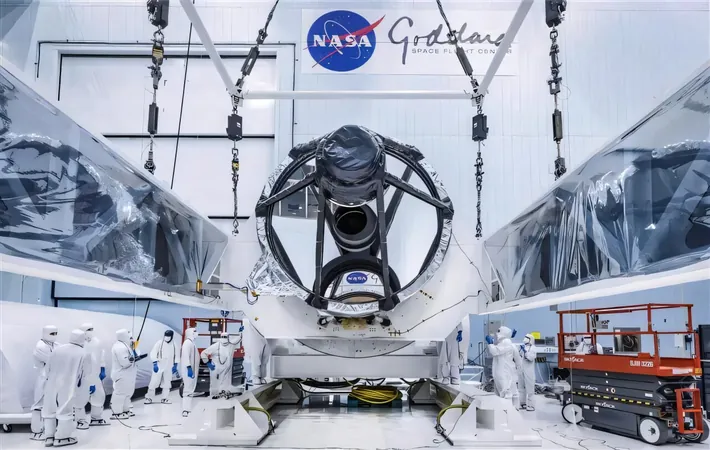
NASA's Roman Telescope Mission Takes a Giant Leap Forward: Major Assembly Delivered!
2024-11-14
Author: Benjamin
NASA’s Roman Space Telescope reaches a pivotal milestone
NASA’s Nancy Grace Roman Space Telescope is preparing to revolutionize our understanding of the cosmos as it nears a pivotal milestone. On November 7th, the Optical Telescope Assembly, a critical component of the mission, was officially delivered to the Goddard Space Flight Center in Greenbelt, Maryland. This assembly features a primary mirror stretching an impressive 7.9 feet (2.4 meters), along with nine additional mirrors alongside essential supporting structures and electronics.
Exploring the universe with advanced technology
The Roman Space Telescope is designed to capture cosmic light, allowing it to survey billions of celestial objects that populate our universe. Equipped with a cutting-edge 300-megapixel infrared camera, known as the Wide Field Instrument, Roman will be able to explore the universe from the edges of our solar system to the very far reaches of the observable universe. In addition, the mission includes an innovative Coronagraph Instrument aimed at developing advanced techniques for imaging planets and their surrounding dusty disks in unprecedented detail.
Expert Insights from NASA's Team
Bente Eegholm, optics lead for the Optical Telescope Assembly at NASA Goddard, expressed the team’s excitement: “We have a top-notch telescope that’s well aligned and has great optical performance under the cold temperatures it will experience in space. I am looking forward to the next phase where the telescope and instruments will be integrated to form the complete Roman observatory.”
Collaboration and meticulous design
The intricate assembly was meticulously designed by L3Harris Technologies, based in Rochester, New York. Notably, key optics, including the primary mirror, were made available to NASA by the National Reconnaissance Office. L3Harris has reshaped and enhanced these components to meet the stringent requirements for Roman’s expansive infrared observations.
Importance of telescope's design and performance
"Success of the telescope is fundamental to the scientific capabilities of the Roman mission, making its design and performance critical to our survey goals," noted Josh Abel, lead Optical Telescope Assembly systems engineer at NASA Goddard.
Rigorous testing and integration
NASA Goddard’s team worked in close collaboration with L3Harris, ensuring that all specifications were met and that the assembly would seamlessly integrate with the rest of the observatory. The process included rigorous individual testing of each optical component before assembly, ensuring that mirror alignments will function as expected when exposed to the extreme conditions of space.
Simulating launch conditions
To simulate launch conditions, the telescope underwent tests that imitated the violent shaking and sound levels encountered during liftoff. Engineers ensured that critical components known as actuators, which will make adjustments to the mirrors in space, were functioning as intended. Upliftingly, the team also addressed the challenges posed by atmospheric gases that could contaminate vital equipment as they transitioned from normal air pressure to a vacuum, simulating the space environment.
Thermal vacuum test success
Perhaps most crucially, the telescope completed an extensive month-long thermal vacuum test, guaranteeing it will endure the harsh temperature and pressure fluctuations of space. With nearly 100 heaters maintaining stable temperatures within a fraction of a degree, Roman will allow for consistent and high-resolution imaging.
Excitement for the launch
The arrival of the assembly at Goddard marks a significant milestone, as it will soon be attached to Roman’s Instrument Carrier, which plays a pivotal role in ensuring optical alignment with the telescope’s two instruments. The electronics box, essentially the telescope's brain, will be integrated within the spacecraft alongside its other electronic systems.
With the successful delivery of this crucial assembly, the Roman Space Telescope is on schedule for its launch, anticipated to take place by May 2027. As excitement builds, many are eager to see how this extraordinary observatory will deepen our understanding of the universe and uncover the mysteries of celestial phenomena. Stay tuned for breaking updates and new discoveries that could reshape our knowledge of the cosmos!









 Brasil (PT)
Brasil (PT)
 Canada (EN)
Canada (EN)
 Chile (ES)
Chile (ES)
 España (ES)
España (ES)
 France (FR)
France (FR)
 Hong Kong (EN)
Hong Kong (EN)
 Italia (IT)
Italia (IT)
 日本 (JA)
日本 (JA)
 Magyarország (HU)
Magyarország (HU)
 Norge (NO)
Norge (NO)
 Polska (PL)
Polska (PL)
 Schweiz (DE)
Schweiz (DE)
 Singapore (EN)
Singapore (EN)
 Sverige (SV)
Sverige (SV)
 Suomi (FI)
Suomi (FI)
 Türkiye (TR)
Türkiye (TR)